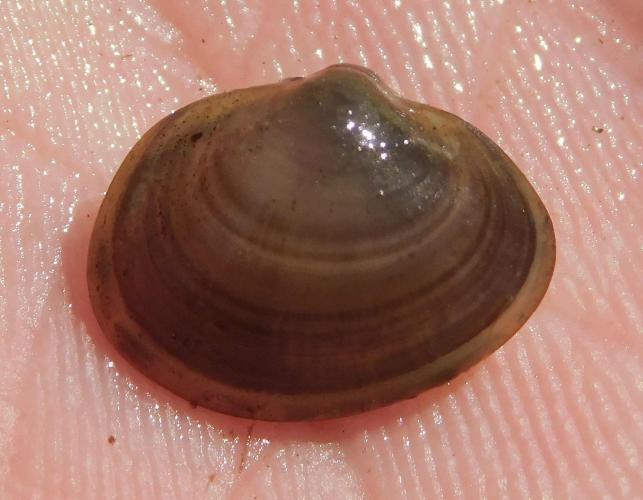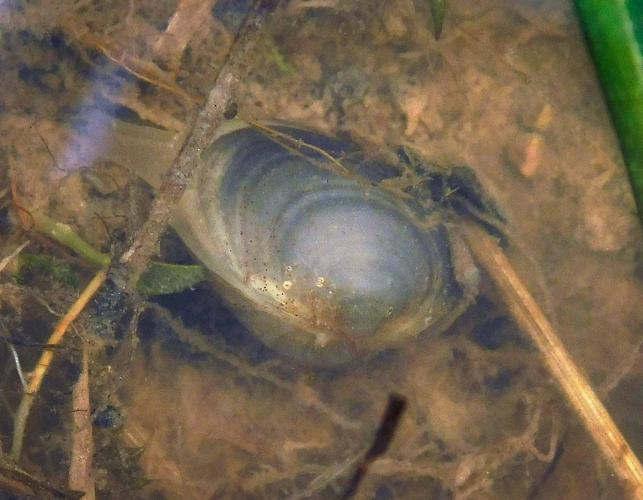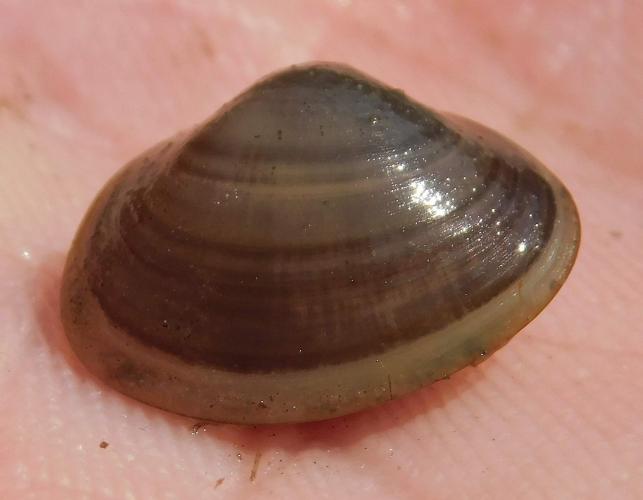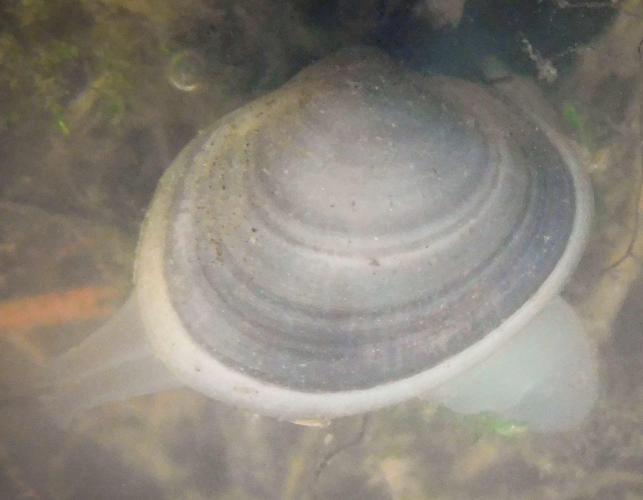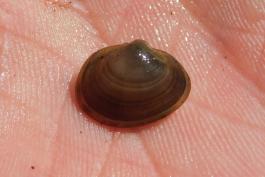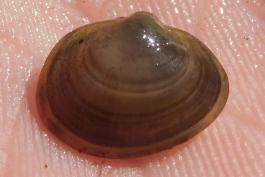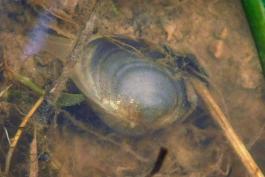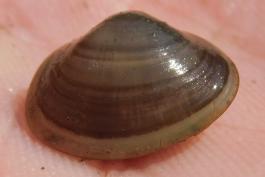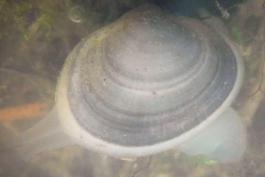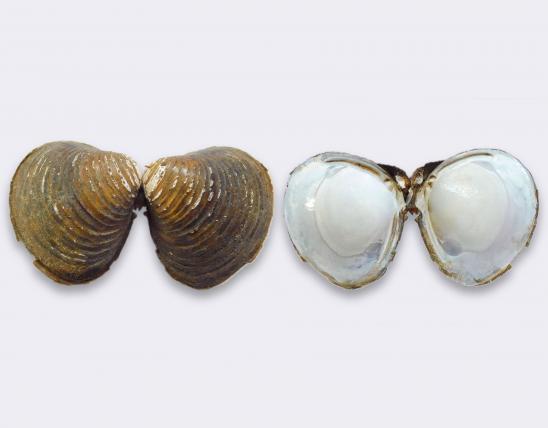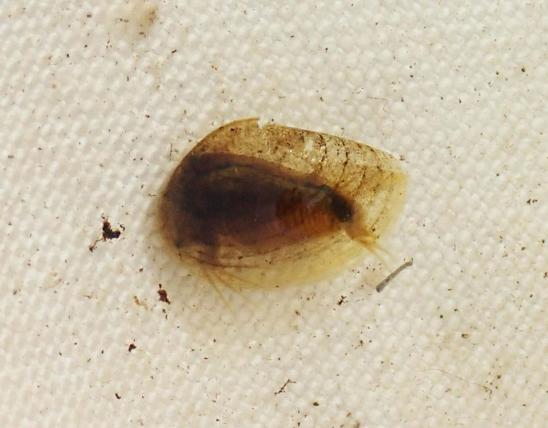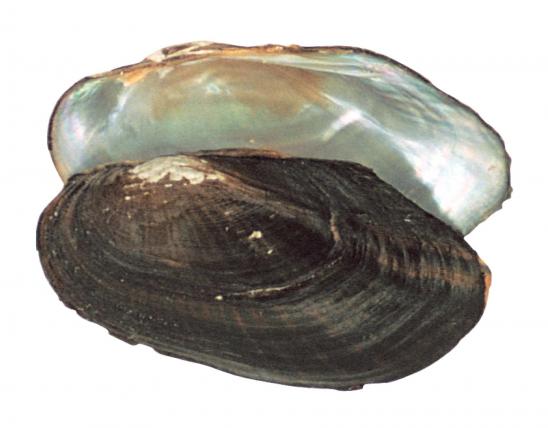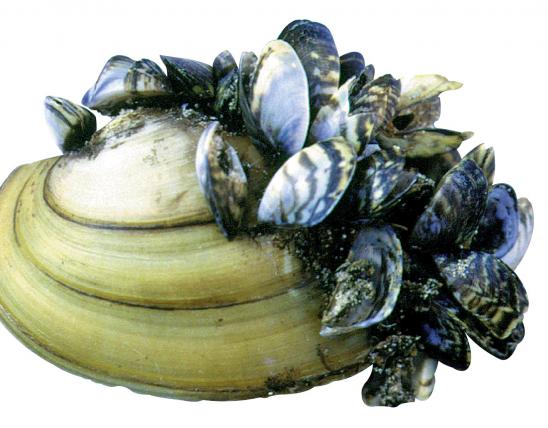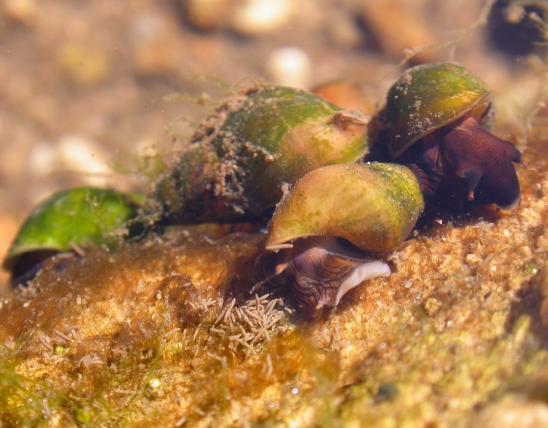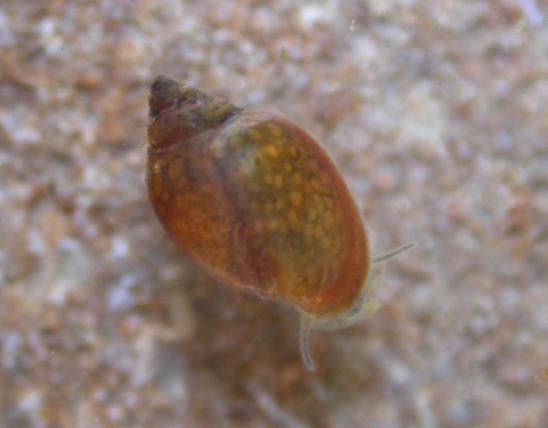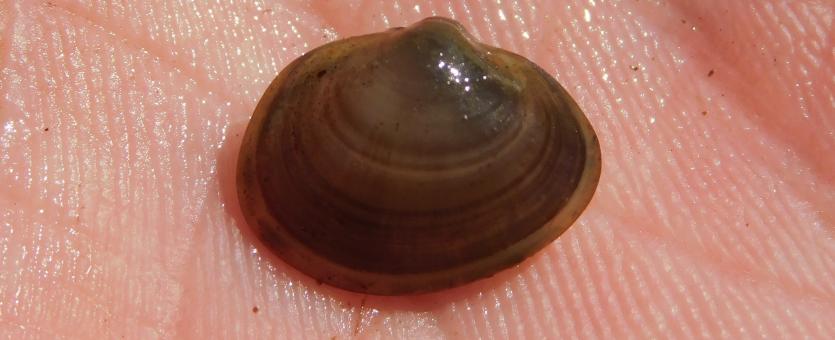
Fingernail clams, also called pill clams or pea clams, are members of a family of small to tiny freshwater clams that are common but rarely noticed. Like other clams, fingernail clams have two mirror-image shells that are hinged together, and the shells are generally rounded to triangular. In fingernail clams, the shells are thin and fragile, often translucent, the outsides typically shiny, fairly smooth, and gray, tan, yellowish, or whitish. Fine growth lines are often visible, but they are not strongly raised, ridged, or rough.
There are numerous species of fingernail clams in North America, in three genera:
- Clams in genus Pisidium typically have the anterior (front) portion of the shell slightly longer than the posterior (rear) portion, so the shell appears fairly lopsided.
- Clams in genus Sphaerium tend to have noticeably rounded, inflated-looking shells, making the closed clam look almost spherical (globe shaped). The beak (umbo, the rounded part near the hinge) is positioned about midway between the front and rear portions of the shell, making each shell look fairly symmetrical.
- Clams in genus Musculium have an extra cap at the tip of the beak that looks like a little bubble or knob; this is the juvenile shell, which remains attached as the shell grows larger.
Key Identifiers:
- Small size, usually less than ½ inch
- Two, mirror-image shells hinged together
- Shells smooth, somewhat translucent, and delicate, with only slightly raised ridges (not a thickened shell with prominent raised ridges)
- Animal is soft-bodied (does not have jointed, shrimplike legs or other appendages)
- Live amid bottom sediments of ponds and other bodies of water; sometimes crawl on plants or other submerged objects
Similar species:
- The invasive, nonnative Asian clam (Corbicula fluminea) reaches a much larger size (to about 2 inches) and has prominent, raised, concentric ridges on its thick, tough shell. Young Asian clams might be confused with fingernail clams, but look for the raised ridges and thick shell. On older specimens, the brownish outer shell covering typically flakes off to show the white layer underneath.
- The glochidia (parasitic juvenile stages) of our native freshwater mussels (order Unionoida) are tiny clams that attach themselves to the fins, skin, or gills of their hosts, which are usually fish. Glochidia are not harmful to their hosts; they remain on the host for only a few days or weeks before dropping off and continuing their development into adult mussels. Adult freshwater mussels grow to much larger sizes than fingernail clams and have an asymmetrical, often oblong shape.
- Clam shrimp (formerly all grouped in order Conchostraca) are actually crustaceans and are not related to clams at all. Their carapace takes the form of two brownish, hinged, dish-shaped shells, which they clamp shut when disturbed, so they look a lot like clams. However, the animal inside has jointed, shrimplike legs and bristly, feathery antennae, which it extends outside the shell and uses for swimming. The shells are usually less than ½ inch long. These fascinating animals are related to fairy shrimp, water fleas, and tadpole shrimp.
Shell length: varies with species; maximum usually no more than ½ inch.
Statewide. Different species have different preferred habitats and different distribution patterns.
Habitat and Conservation
Fingernail clams are found in a variety of aquatic habitats, usually in places with mucky or sandy substrates, and usually at or just under the bottom substrate. Some types of fingernail clams will also crawl around on submerged aquatic plants or other objects, using their muscular foot. Different species have different habitat preferences.
Some species of fingernail clams are specially adapted to live in vernal pools — temporary ponds, usually in woodlands, that fill with water in springtime, then dry up during summer. As the pool dries, the fingernail clams burrow down several inches into the soil, where it is moist enough for them to survive until the next spring.
Food
Fingernail clams, like scallops, mussels, oysters, and most other bivalve molluscs, are filter feeders that remove suspended organic materials from water: algae, tiny planktonic animals, plant and animal detritus, and so on. They have tubelike siphons that draw water and tiny, drifting food particles into the shell cavity. A pair of flaplike, mucous-covered gills collects the goodies and channels them to the animal’s mouth, situated at one part of the gill. Waste products are expelled from the shell cavity via excurrent water flow.
Life Cycle
Like most other molluscs, fingernail clams are hermaphrodites: each individual can produce both eggs and sperm. Fingernail clams are able to fertilize their own eggs. They retain the eggs and newly hatched young in an internal brood pouch (called a marsupium, like the pouch of an opossum). The larval fingernail clams remain in their mother/father’s marsupium until they are surprisingly large and well-developed, sometimes being as much as a fourth or a third the size of the parent. Around 20 larval fingernail clams, in various stages of development, may be present in a fingernail clam’s marsupium at any given time.
Fingernail clams, being very small for clams, produce young that are surprisingly large considering their adult size. Biologists point out that there are tradeoffs between producing rather large, well-developed young in relatively small numbers, versus tiny, undeveloped young in masses:
- In cases where there are fewer, but larger and better-equipped young, the expense to parents is great, but the payoff in the percentage of offspring that survive to adulthood is great as well (think of a pair of birds laboriously tending their nest, feeding their hatchlings, driving away predators and rivals, and so on).
- On the other hand, where the parental expenditure is low, but the numbers of offspring are many, mortality is high, but the odds of a few of them surviving to adulthood is also great (think of freshwater mussels broadcasting clouds of sperm and eggs into the water, and having little other parental investment beyond their bodies making and expelling the gametes).
In the animal kingdom, both strategies can be effective.
Human Connections
Going on field trips to study pond life is a highlight of many children’s science education. In addition to a fun day out in nature, it also teaches kids how stream ecologists can gauge a stream’s health by what kinds of invertebrates are present. Kids use dip nets and shallow white bowls to fish out, sort through, and identify the many strange invertebrates that live in the shallow water of a pond edge. Fingernail clams are often one of the discoveries. What a surprise to find tiny clams living in Missouri!
Many people are fascinated by dinosaurs. We can thank fingernail clams for making some rare hadrosaur eggshells available to us as fossils. Usually, these egg fragments didn’t last long enough to become fossilized because mildly acidic conditions would dissolve the shells’ calcium before fossilization could take place. However, in certain locations, the shell fragments were preserved — in rock formations dominated by fossilized fingernail clam shells. The many calcium-rich clam shells buffered the water, preventing it from becoming acidic, and preventing the dissolution of the egg fragments.
Ecosystem Connections
Fingernail clams are filter feeders that remove suspended organic materials from water, so they tend to clarify the water. It also means that they are an early step in aquatic food webs, since they consume tiny suspended algae and other foods and convert it to the form of their bodies. Then, they may be eaten by fishes, birds, and mammals that aren’t bothered by their small shells. Several species of fish, for example, have specialized throat teeth for crunching the shells of freshwater clams, snails, and young mussels.
The vernal pools that some fingernail clams live in are famous for being important habitat for amphibians. In spring, salamanders, newts, frogs, and toads travel to these fishless ponds to mate and lay eggs. Because these ponds lack fish (which would eat them), the eggs, tadpoles, and larval salamanders can grow to maturity in relative safety. The fingernail clams and other invertebrates in these pools are important parts of these fascinating, temporarily aquatic ecosystems.
Apparently, fingernail clams can move from one isolated vernal pool to another by clamping on to a finger or toe of a salamander, frog, or other animal. Remember that fingernail clams can fertilize their own eggs, so only one individual can start a population. Biologists have witnessed this hitchhiking phenomenon in the vernal pools of northern states. This seems to be the way these clams came to inhabit so many vernal pools long ago.
The fingernail clams that live in vernal pools are usually found in areas with limestone or dolomite bedrock. Why? Because without limestone or dolomite rocks to buffer (raise the pH of) the soil and water, the decaying leaves and other organic materials on the floor of the woods would tend to make the environment somewhat acidic — and an acidic environment would either damage the clams’ fragile shells or prevent them from forming at all. Also, clams need calcium in the environment to build their shells, and limestone and dolomite provide it.

